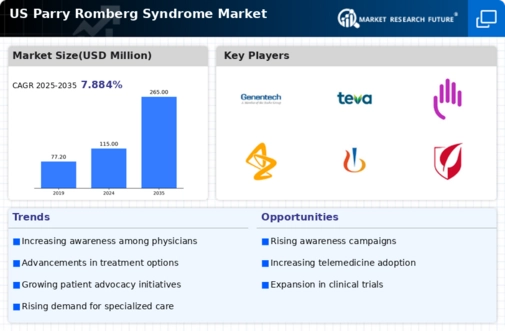Rising Demand for Specialized Care
There is a notable rise in demand for specialized care within the parry romberg-syndrome market. Patients with this condition often require multidisciplinary approaches involving dermatologists, neurologists, and reconstructive surgeons. As awareness of the syndrome increases, more patients are seeking specialized clinics and healthcare facilities that offer comprehensive management strategies. This trend is likely to drive the establishment of dedicated centers of excellence focused on parry romberg syndrome, enhancing patient access to tailored care. Furthermore, the growing emphasis on patient-centered approaches in healthcare is expected to lead to improved treatment outcomes and satisfaction. Consequently, the demand for specialized care is anticipated to significantly influence the growth of the parry romberg-syndrome market.
Advancements in Diagnostic Technologies
Innovations in diagnostic technologies are significantly impacting the parry romberg-syndrome market. Enhanced imaging techniques, such as MRI and CT scans, allow for more accurate and timely diagnosis of the syndrome. These advancements facilitate early detection, which is crucial for effective management and treatment. As diagnostic tools become more sophisticated, healthcare providers are better equipped to identify parry romberg syndrome, leading to an increase in patient referrals and subsequent treatment options. The market is likely to benefit from the integration of artificial intelligence and machine learning in diagnostic processes, which could streamline patient assessment and improve outcomes. This evolution in diagnostics is expected to contribute positively to the growth trajectory of the parry romberg-syndrome market.
Growing Research and Development Investments
The parry romberg-syndrome market is witnessing a surge in research and development investments aimed at understanding the underlying mechanisms of the syndrome. Increased funding from both public and private sectors is fostering innovation in treatment modalities. For instance, recent studies have explored the genetic and environmental factors contributing to the syndrome, which may lead to the development of targeted therapies. The US government has allocated substantial resources to rare disease research, which could enhance the understanding of parry romberg syndrome and promote the creation of effective treatment options. This influx of investment is likely to stimulate market growth, as new therapies emerge and existing ones are refined, ultimately benefiting patients and healthcare providers alike.
Increasing Incidence of Parry Romberg Syndrome
The parry romberg-syndrome market is experiencing growth due to the increasing incidence of this rare condition in the US. Recent estimates suggest that the prevalence of parry romberg syndrome may be around 1 in 200,000 individuals, leading to a heightened demand for diagnostic and therapeutic solutions. As awareness of the syndrome grows among healthcare professionals and the general public, more patients are likely to seek medical attention, thereby driving market expansion. The rising number of diagnosed cases is expected to create opportunities for pharmaceutical companies and healthcare providers to develop targeted treatments and interventions. This trend indicates a potential increase in market revenue, as the need for specialized care and management strategies becomes more pronounced in the parry romberg-syndrome market.
Emerging Therapeutic Options and Clinical Trials
The parry romberg-syndrome market is poised for growth due to the emergence of new therapeutic options and ongoing clinical trials. Pharmaceutical companies are increasingly investing in the development of innovative treatments, including biologics and gene therapies, which may offer more effective solutions for managing the syndrome. The active participation of research institutions in clinical trials is crucial for evaluating the safety and efficacy of these new therapies. As more clinical trials are initiated, the potential for breakthrough treatments increases, which could reshape the treatment landscape for parry romberg syndrome. This dynamic environment is likely to attract interest from investors and stakeholders, further propelling the growth of the parry romberg-syndrome market.






















Leave a Comment